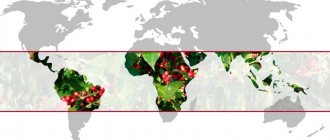History with geography
The coffee industry is one of the main sectors in the country's economy, so it is not surprising that the majority of the country's population works here. Among the world's exporters, Guatemala is definitely in the TOP 10. Who made seemingly ordinary coffee beans so famous?
Coffee seedlings appeared in Guatemala thanks to Jesuit monks. It was they who, together with the word of God, brought coffee grains to Central America to the aborigines in the 18th century. But the country's climate is completely unsuitable for high yields. Therefore, for almost a century, the plantations of this plant were quite modest. The scorching sun did not give the fragile trees a chance.
But in the 19th century, the country's leadership relied on the coffee industry. It was as a result of this that European settlers received large plots of land in the country. And the decision did not take long to arrive.
For new plants, they found a place in the shade of trees and thus protected the sprouts from heat and direct sunlight. As a result, coffee plantings spread and occupied large areas of Guatemala.
Today, more than 800 million coffee trees grow here. It should be noted that the country takes a responsible approach to the coffee industry, which means strict quality control of products at all stages of production and the export process.
Why did Arabica take root?
Initially, little attention was paid to coffee production. But as soon as the residents themselves appreciated the taste of the roasted grains, their aroma and properties, it was decided to develop mountain plantations. This is how new varieties appeared in the coffee industry, and the first batches of exported Guatemala coffee beans were sent to Europe and America.
It was for the Arabica variety that the heights became comfortable territory for rich harvests. Therefore, intolerant leguminous plants are perfectly located here. This also applies to other excellent coffee varieties, which is why they are grown mainly in mountainous areas. On the plains, plants simply do not take root. There are about eight regions in the country where coffee is grown. There is a low level of humidity, no heat or scorching sun, and the cleanest air. These areas include the following:
- Quiche;
- Oriente;
- Atitlan;
- Nuevo;
- Koban;
- Antigua.
These areas are located much above sea level. Soil is of particular value for growing coffee. Saturated with oxygen and also rich in minerals. This composition is ideal for growing quality grains. Coffee varieties differ in their taste. And only true connoisseurs will be able to recognize grains that are grown in different regions.
Geography of growth
Guatemala has one of the most diverse climates for coffee production in the world. The plantations are located in seven regions, the most popular of which are Antigua, Huehuetenango and Atitlan. Each region has unique coffee flavor profiles, natural conditions, microclimates, soils and growing altitudes.
Antigua coffee is grown on the slopes of volcanoes in arid and sunny areas. It is the most famous growing area and is also home to the oldest coffee plantations in the country, some of which have been passed down from generation to generation in the same family. Beans from this region are characterized by a dense body and sweetness with low to medium acidity. Chocolate taste and fruity tones are the hallmarks of beans from Antigua.
The Huehuetenango region near the Mexican border has the highest altitudes: up to 2,000 meters. The coffee is dominated by bright sourness with fruity tones. Varieties from this region can be compared to coffee from Ethiopia, only Guatemalan has a denser body. Our Sierra Morena coffee is produced here.
Coffee trees in Atitlán also grow in volcanic soils near the lake of the same name. Water from this reservoir is used for grain processing. The area here is windier and wetter, and the coffee is dominated by nutty and chocolate notes.
Other regions include the Fraijanes Plateau, surrounding Guatemala City (the country's capital); tropical forests of Coban in the north of the country with a humid climate; San Marcos Volcano, the warmest and wettest region; arid Oriente region with volcanic soil.
Since the country abounds in rainfall, the main method of processing there is washed. High humidity levels prevent farmers from processing grains naturally or dryly.
Manufacturers also prefer washed processing, as they believe that it better highlights the inherent acidity of Guatemalan grains than natural processing.
Growing
An important factor in the prosperity of the coffee industry is the diversity of Guatemala's territory. There are high mountain areas, plateaus and foothills. The quality of coffee beans is directly proportional to the height at which the plantation is located. The higher, the stronger the plant, the higher the density of the coffee beans, the more concentrated aroma and taste. While coastal grains grow under the influence of sea winds.
The highest quality Guatemalan coffee is grown near the country's main city. Near the capital of Guatemala, Antigua, coffee is distinguished by its qualities due to the fact that the plants grow on the soil of an extinct volcano.
During the growing process, no accelerators or additives are used for plants.
For growing Guatemalan coffee, the optimal temperature is 16-13 degrees. Plants hide in the shade of trees. The harvest takes place once a year and lasts from November to April.
There are both dry and wet processing methods. The first one is more popular and cheaper. But the rainy climate determines the second option. And sudden tropical downpours will not spoil coffee that dries in the sun.
Taste of Guatemala coffee
The soil on which coffee grows has a layer of ash left over from volcanic activity. High yields are also possible due to the presence of organic matter in the soil. It is for these reasons that the plant has a smoky hue. The special spicy aroma and intense taste belong to elite varieties whose plantations are located on former volcanic peaks. If the plants grow lower, the taste of such a drink becomes softer and the smell is not so intense.
The grains that are grown in the coastal zone are distinguished by tarsal odors, and the taste has a special sourness, which is characteristic of fruits.
Even if it is not so attractive to real coffee lovers, its taste should not be missed or underestimated. In it, everyone can also feel the smoky note in the aroma.
Features of Guatemalan coffee
The lion's share of Guatemalan coffee is Arabica - there are a variety of varieties. Mostly typical. Quite a lot of it has been preserved here. Let me remind you that after coffee rust, this variety died on almost all the world's plantations. And the whole thing was saved by robusta.
How to grow
The landscape in this country is very diverse:
- Foothills;
- Highlands;
- Plateau.
Let me remind you that the higher the coffee tree grows, the more highly valued its grain is. What conclusion can be drawn? Products of various quality are collected here.
Premium varieties are grown on plantations located near the capital Antigua. Once there was a volcano here, but now there is a very fertile post around it. Height from 1350 meters and above.
What’s interesting is that all the plantings here are grown naturally. No chemicals, growth accelerators, etc. are used. This is another plus for Guatemalan coffee. Learn about the chemical composition of coffee.
Taste qualities
As noted above, premium coffee is grown on volcanic peaks. This leaves certain imprints on the taste. The prepared drink will have a slight smoky note. Agree, very cool?
Grains collected on plantations located below do not have such a strong taste. It will be somewhat softer and have a pleasant fruity taste. The coffee will be less strong, more delicate.
Types and varieties of Guatemalan coffee
Guatemalan coffee has long been popular and especially prized for its versatility. After all, such grains can be fried to any degree:
- strong;
- average;
- weak.
Regardless of the level of roasting of Guatemala coffee, the taste remains unique and the aroma is unique. The variety is the richest. In this drink, coffee lovers will be able to feel notes of fresh apple and even rich chocolate aroma with added spices.
Depending on the location of the plantation, the grains have different markings. If they were grown at an altitude of 1500 meters, then coffee bean connoisseurs may see the name Hard Bead (HB). Those plants that are located even higher are called Strongly Hard Bean (SHB).
Among the main varieties of Arabica, Guatemala is proud of the following:
- Catuai;
- Pace;
- Bourbon;
- Caturra;
- Typical.
Guatemala Antigua
This variety is especially valued all over the world and occupies an honorable place among the elite varieties. Guatemala antigua coffee gets its name from the region where the plantation is located. This is the highest place in the country. Guatemala coffee has a particularly rich flavor that only fully reveals itself after a few sips. In the bouquet you can feel notes of cocoa, prunes, and chocolate aromas. Fruity aromas add a special taste.
Antigua and other varieties
What varieties can be found on the shelves of our stores and which ones are worth our attention?
Guatemala Antigua
An elite variety of coffee grown in the highest mountains of the country. It was named after the geographical region. The finished drink is dense and rich, the taste is multifaceted and complex. The smoky aroma is noticeable in it. The coffee opens up with every sip; notes of chocolate, cocoa, and sometimes prunes are discernible. The range ends with light fruity nuances.
The variety is perfect for cooking in a cezve, for brewing in a pour-over, or simply in a cup.
Guatemala Cabano
It may cost more than Antigua due to the capricious climate, which results in additional production costs. The variety has a rich flavor bouquet, with light nutty notes, nuances of chocolate, cocoa and floral notes. Its aroma is subtler than that of Antigua. The Cabano variety is well suited for preparing coffee using alternative methods: in a Chemex or pour over.
Maragogyp
Imported from Brazil, famous for its large grains. It is strongly reminiscent of Brazilian coffee, has a well-defined bitterness and sharp sour notes. Can be prepared in a drip coffee maker or Turkish coffee maker.
Guatemalan coffee
The variety is called exactly that - Guatemala. It deserves the attention of those who love unusual flavor accents. The coffee has a spicy pungency and a bright aroma with notes of chocolate and peanuts, and a distinct smoky taste. Like the best varieties, the bouquet reveals gradually, from a thick chocolate-nut to a warm bready taste. Ideal for Aeropress, pour-over, can be cooked in a cezve on sand or in a regular Turkish pot over low heat.
Cames
One of the plantation monovarietals. The finished drink is dense, with a thick, rich taste. The aroma is fruity and nutty, with a citrusy refreshing sourness. Great for French press and cup brewing, and fine grind for cezve.
Where to buy Guatemala coffee
These varieties of coffee, which come to us from Guatemala, are available in specialized coffee shops. Coffee lovers who value their time and do not have the desire to run around the city will be able to find the desired beans in the online store. Here you can find any varieties from the most popular plantations in Guatemala.
The cost will differ depending on the variety, producers and year chosen by the client. The price for 100 g of freshly roasted beans can vary from 200 to 400 rubles. True connoisseurs of such a popular drink recommend giving preference to freshly roasted beans.
Guatemala Coban Honey
Coffee in Guatemala
The first coffee trees were introduced to Guatemala, as well as to most countries in Central and South America, at the end of the 18th century. In the 1860s, with the arrival of European immigrants, coffee farming was strengthened and industrial coffee production was established. With the country's main export crop (the indigo plant from which blue dye is made) having recently failed and the government urgently trying to find a replacement, farmers have been given seeds and young coffee plants to encourage agricultural development.
By the end of the 19th century, Guatemala was exporting almost 140 million kg of coffee annually. Until 2011, the country was one of the five largest coffee-producing countries in the world, but due to the coffee leaf disease epidemic, it gave way to Honduras.
A large percentage of Guatemala's population is indigenous. More than 20 ethnic groups are officially recognized and registered here. Local farmers and workers on plantations are predominantly representatives of ancient peoples: Mayans, Quiche, Mame, Qeqchi, Kaqchikel and others.
Most farmers are smallholders who either organize into independent farms consisting of several related families or into cooperatives.
Koban
The municipality of Coban and the city of the same name are the center of a large coffee region in central Guatemala. Here, at an altitude of 1300-1500 meters above sea level, coffee has been grown since the end of the 19th century.
It always rains in Kobana and is foggy and cool all year round. When locals say the rain is letting up, what they really mean is that it's drizzling. The fog never subsides, only sometimes it turns into “chipi-chipi”, which is translated from the local dialect as “light fog”. The name “Koban” itself means “foggy place” in the language of the Qeqchi people.
Sometimes coffee producers even list the name of the region as Rainforest Cobán. 3000-4000 mm of precipitation falls here annually. Drying coffee outdoors is difficult, so most manufacturers use mechanical drying.
Traditionally, coffee from this region has juicy notes of fresh tropical fruits and citrus. The common characteristics of quality coffee from different regions of Guatemala are considered to be: good balance, clean taste, clear descriptors that do not mix or overlap, a round body and moderate acidity.
Honey Process
This method is similar to the washed processing method. Coffee berries are depulped (the peel and part of the pulp are removed) in the same way as when washed, but they leave a thin layer of sweet gluten and the grain is dried in it.
During drying, the gluten caramelizes and becomes similar to honey. That's why the method is called Honey. Coffee processed this way has a creamier, rounder body than washed coffee, and tastes like sweet notes of candied fruits and candied fruits. At the same time, it retains the clean and balanced profile inherent in washed coffee.
How to brew Guatemalan coffee
Guatemalans do not have a specific method of preparing the drink, and they do not have one recipe. Therefore, everyone can experiment and choose the option that suits their taste.
The main rule to follow is to avoid using boiling water. The optimal water temperature should not be more than 95 degrees.
Do not allow the drink to boil in the Turk. This method can minimize the amount of microelements and vitamins in the coffee drink.
Still, there are a few secrets that should be followed:
- The beans should be ground before preparing the drink;
- refuse tap water;
- to avoid spoiling the taste, use filtered water;
- add a minimal amount of sugar;
- do not abuse the dosage – 1 tsp. ground coffee per 50 ml of liquid.
This is how Guatemalan coffee varieties reveal their deep flavor and aroma.











